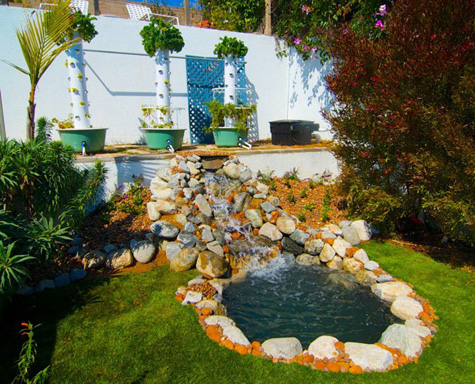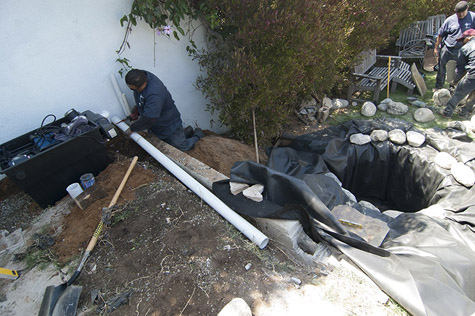
There is no doubt that we are living in changing times. Some 20 years ago, the modern U.S. pond movement was well underway, escalating in sales and progressive technology. Business empires were built and new manufacturers appeared. Then, about five years ago, the recession took a toll on all businesses, including those in the pond world. About a year ago, the recession began lifting and the pond world began to pick up. Then a new challenge began, which was creeping slowly but has now gained momentum and is threatening to unseat the popularity of ponds as part of the outdoor living experience.
The Mega-Drought
The challenge is real, and it is known as the Mega-Drought. How bad is this drought? For the first time in American history, over half the United States has declared drought. For the first time in California history, the entire state is under drought and the governor has declared a historic, 25 percent mandatory water reduction.
The result? People are now taking shorter showers, irrigating landscapes only one to two days per week…and draining water features. Many cities have put residents on notice that, if the drought continues in its persistent ways, all outdoor watering for landscaping purposes will be outlawed. Many fountains in public places such as malls and government buildings have been drained.
Is this drought as serious as it is being portrayed? Well, the top water scientist for NASA stated in February of this year that California has one year left in water reserves. On another front, drought means less water for growing food crops. Did you know that 65 percent of the fresh fruits and veggies grown for the USA come from central California? Drought means significantly higher food prices. Higher water prices bring higher food prices, and perhaps ponds will be villainized like turf grass, where local city governments are paying homeowners to remove their lawns and install native succulents and cactus.
[box]After the hole is dug and waterfall shaped, left, we are ready for liner placement and filter hook up. Pre-Landscaping, right, which included Rain Bird Sustainable Copper Shield Drip Irrigation.[/box]
Yes, it is as bad as people are reading…and this is just the tip of the iceberg. Now is the time to move as fast as we can to put ponds in a good light. How? By educating the public that ponds are not the villain; rather, they are part of the sustainable solution for helping us cope with the current drought. Aside from providing refuge and water for wildlife and beneficial insects and creating a stressless environment that promotes mental well-being, ponds can actually help in a twofold way.
Ponds to the Rescue
We have heard that humanity’s carbon footprint needs to be reduced. We can do this by driving less. One way to help fight carbon emissions is growing our own food, or a portion of our food. Think about it: the average tomato travels about 1,000 miles to go from farm to table. The environmental cost to make this happen is very great. Growing our own is good for the environment and is the only way we can be sure we are getting organic food that is free of pesticides, herbicides and genetically modified organisms (GMOs).
Aquaponics
Did you know that agriculture accounts for about 80 percent of water use in California? Is there a way ponds can help turn the tide? The answer is a resounding “Yes!” This can be achieved by incorporating aquaponics in our ponds.
Aquaponics refers to growing food with pond water. Many cultures have done this for centuries; however, modern technology makes it possible to do so with the added benefit of recycling and reusing the same water over and over. Many people get excited when they think of the practice of using “greywater,” which is piping the wastewater from the clothes washer or shower to water the landscape. This results in water being used twice.

Reusing greywater is a great idea and is being hailed as a great example of sustainability. Aquaponics, if done right, will recycle and reuse the same water not twice or three times, but 100 times over. It seems like a dream come true, and this is why I wrote the article—to show that dreams do come true! What might be viewed as a problem is really a part of the solution.
We have been building our water gardens and koi ponds as we always have, but we now add a second small Pond Boss pump, which feeds the nutrient-rich pond water to aeroponic systems, which we convert into aquaponic systems.
Aeroponics is a lot like aquaponics. However, aeroponics uses tap water and liquid fertilizer. An aquaponic system pumps pond water directly to the veggie roots, then back to the pond. This is a closed loop system, resulting in about 95 percent water savings over a traditional soil garden!
Why Aquaponics?
A head of lettuce is very water-intensive and takes about 100 gallons to grow from seed to salad. In an aquaponic system, growing the same head of lettuce from seed to salad takes about 3 gallons! We like vertical systems because growing vertically saves space and helps keep pests at bay. We put a timer on our vertical gardens, and the magic formula is a running time of 15 minutes on and 15 minutes off, 24/7. Food will grow two to three times faster due to increased oxygen levels. No composting, no weeding … and best of all, the University of Mississippi did a study of this type of growing and found that food grown in these types of systems are more nutrient-dense. What is the downside? If you don’t harvest, the food will turn to seed! Eating from your garden is never a problem.
If you decide that being a part of the solution is where you want to take your company, build a vertical aquaponic system and then spread the word by making YouTube videos and posting pics to social media. You will become part of the solution and feature ponds in a good light. Together, we can all make a difference for our customers, our businesses and our health.









